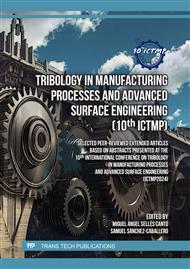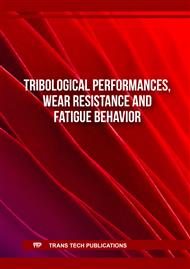[1]
da Silva, W.T.A., J. Peterka, and T. Vopat, Experimental Research on the Dynamic Stability of Internal Turning Tools for Long Overhangs. Journal of Manufacturing and Materials Processing, 2023. 7(2): p.61.
DOI: 10.3390/jmmp7020061
Google Scholar
[2]
Suyama, D. and A. Diniz, Influence of tool vibrations on tool wear mechanisms in internal turning of hardened steel. Journal of the Brazilian Society of Mechanical Sciences and Engineering, 2020. 42: pp.1-17.
DOI: 10.1007/s40430-020-02452-w
Google Scholar
[3]
Totis, G. and M. Sortino, Robust analysis of stability in internal turning. Procedia Engineering, 2014. 69: pp.1306-1315.
DOI: 10.1016/j.proeng.2014.03.123
Google Scholar
[4]
Östling, D., et al., Cutting process monitoring with an instrumented boring bar measuring cutting force and vibration. Procedia CIRP, 2018. 77: pp.235-238.
DOI: 10.1016/j.procir.2018.09.004
Google Scholar
[5]
Fallah, M. and B. Moetakef-Imani, Design, analysis, and implementation of a new adaptive chatter control system in internal turning. The International Journal of Advanced Manufacturing Technology, 2019. 104: pp.1637-1659.
DOI: 10.1007/s00170-019-03808-w
Google Scholar
[6]
Basovich, S. and S. Arogeti, Identification and robust control for regenerative chatter in internal turning with simultaneous compensation of machining error. Mechanical Systems and Signal Processing, 2021. 149: p.107208.
DOI: 10.1016/j.ymssp.2020.107208
Google Scholar
[7]
Yan, S. and Y. Sun, Enhancing tool dynamics and stability in internal turning with an adjustable clamping device under variable cutting conditions. Mechanical Systems and Signal Processing, 2024. 208: p.111007.
DOI: 10.1016/j.ymssp.2023.111007
Google Scholar
[8]
Suyama, D.I., A.E. Diniz, and R. Pederiva, The use of carbide and particle-damped bars to increase tool overhang in the internal turning of hardened steel. The International Journal of Advanced Manufacturing Technology, 2016. 86: pp.2083-2092.
DOI: 10.1007/s00170-015-8328-z
Google Scholar
[9]
Fu, Q., D. Lundin, and C.M. Nicolescu, Anti-vibration engineering in internal turning using a carbon nanocomposite damping coating produced by PECVD process. Journal of materials engineering and performance, 2014. 23: pp.506-517.
DOI: 10.1007/s11665-013-0781-y
Google Scholar
[10]
Hendrowati, W. and N. Merdekawan, Modeling and analysis of boring bar vibration response in internal turning due to variation of the amount of DVA rubber in finish boring cut. Journal of Mechanical Science and Technology, 2021. 35: pp.4353-4362.
DOI: 10.1007/s12206-021-0907-3
Google Scholar
[11]
Basovich, S., E. Mizrachi, and S. Arogeti, Novel actuation approach for active control of slender bars with simulated delayed excitation. Mechatronics, 2019. 57: pp.51-62.
DOI: 10.1016/j.mechatronics.2018.11.010
Google Scholar
[12]
Thorenz, B., et al., Evaluation of the influence of different inner cores on the dynamic behavior of boring bars. Procedia CIRP, 2019. 81: pp.1171-1176.
DOI: 10.1016/j.procir.2019.03.287
Google Scholar
[13]
Sørby, K. and D. Østling, Precision turning with instrumented vibration-damped boring bars. Procedia Cirp, 2018. 77: pp.666-669.
DOI: 10.1016/j.procir.2018.08.181
Google Scholar
[14]
Fallah, M. and B. Moetakef-Imani, Adaptive inverse control of chatter vibrations in internal turning operations. Mechanical Systems and Signal Processing, 2019. 129: pp.91-111.
DOI: 10.1016/j.ymssp.2019.04.007
Google Scholar
[15]
Paramasivam, B., Investigation on the effects of damping over the temperature distribution on internal turning bar using Infrared fusion thermal imager analysis via SmartView software. Measurement, 2020. 162: p.107938.
DOI: 10.1016/j.measurement.2020.107938
Google Scholar
[16]
Ebrahimi, A. and M. Moshksar, Study of machinability in boring operation of microalloyed and heat-treated alloy steels. Materials Science and Engineering: A, 2007. 460: pp.314-323.
DOI: 10.1016/j.msea.2007.01.050
Google Scholar
[17]
Rao, K.V., B. Murthy, and N.M. Rao, Prediction of cutting tool wear, surface roughness and vibration of work piece in boring of AISI 316 steel with artificial neural network. Measurement, 2014. 51: pp.63-70.
DOI: 10.1016/j.measurement.2014.01.024
Google Scholar
[18]
de Aguiar, H.C.G., et al., Reduction of internal turning surface roughness by using particle damping aided by airflow. The International Journal of Advanced Manufacturing Technology, 2020. 106: pp.125-131.
DOI: 10.1007/s00170-019-04566-5
Google Scholar
[19]
Vieira, J.T., et al., Multi-objective robust evolutionary optimization of the boring process of AISI 4130 steel. The International Journal of Advanced Manufacturing Technology, 2021. 112: pp.1745-1765.
DOI: 10.1007/s00170-020-06455-8
Google Scholar
[20]
Vopát, T., et al., The Selection of Cutting Speed to Prevent Deterioration of the Surface in Internal Turning of C45 Steel by Small-Diameter Boring Bars. Machines, 2024. 12(1): p.68.
DOI: 10.3390/machines12010068
Google Scholar
[21]
Rao, K.V., et al., An artificial neural network approach to investigate surface roughness and vibration of workpiece in boring of AISI1040 steels. The International Journal of Advanced Manufacturing Technology, 2016. 83(5): pp.919-927.
DOI: 10.1007/s00170-015-7621-1
Google Scholar
[22]
Rao, K.V., B. Murthy, and N. Mohan Rao, Experimental study on surface roughness and vibration of workpiece in boring of AISI 1040 steels. Proceedings of the Institution of Mechanical Engineers, Part B: Journal of Engineering Manufacture, 2015. 229(5): pp.703-712.
DOI: 10.1177/0954405414531247
Google Scholar
[23]
Yildiz, Y., M. Gunay, and U. Seker, The effect of the cutting fluid on surface roughness in boring of low carbon steel–technical communication. Machining Science and Technology, 2007. 11(4): pp.553-560.
DOI: 10.1080/10910340701697052
Google Scholar
[24]
Munawar, M., J.C.-S. Chen, and N.A. Mufti, Investigation of cutting parameters effect for minimization of sur face roughness in internal turning. International journal of precision engineering and manufacturing, 2011. 12: pp.121-127.
DOI: 10.1007/s12541-011-0015-x
Google Scholar
[25]
Hassan, K., et al., Grey based multi-objective optimization of machining performance in boring of aluminium alloy 6061 through piezoelectric shunt damping. Materials Today: Proceedings, 2022. 50: pp.1043-1047.
DOI: 10.1016/j.matpr.2021.07.450
Google Scholar
[26]
Yang, R.-T., et al., Modeling and optimization in precise boring processes for aluminum alloy 6061T6 components. International Journal of Precision Engineering and Manufacturing, 2012. 13: pp.11-16.
DOI: 10.1007/s12541-012-0002-x
Google Scholar
[27]
Cozzens, D., et al., An experimental investigation into the effect of cutting fluid conditions on the boring of aluminum alloys. 1999.
Google Scholar
[28]
Chakraborty, S., H.N. Datta, and S. Chakraborty, Grey relational analysis-based optimization of machining processes: A comprehensive review. Process Integration and Optimization for Sustainability, 2023. 7(4): pp.609-639.
DOI: 10.1007/s41660-023-00311-4
Google Scholar
[29]
Tsao, C., Grey–Taguchi method to optimize the milling parameters of aluminum alloy. The International Journal of Advanced Manufacturing Technology, 2009. 40(1): pp.41-48.
DOI: 10.1007/s00170-007-1314-3
Google Scholar
[30]
Jomaa, W., et al., Optimization study of dry peripheral milling process for improving aeronautical part integrity using Grey relational analysis. The International Journal of Advanced Manufacturing Technology, 2016: pp.1-12.
DOI: 10.1007/s00170-016-9777-8
Google Scholar
[31]
Xu, H., An algorithm for constructing orthogonal and nearly-orthogonal arrays with mixed levels and small runs. Technometrics, 2002. 44(4): pp.356-368.
DOI: 10.1198/004017002188618554
Google Scholar



